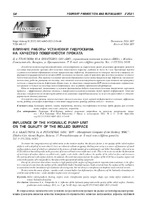| dc.contributor.author | Глазунова, Н. А. | |
| dc.contributor.author | Потапенко, Ю. А. | |
| dc.coverage.spatial | Минск | ru |
| dc.date.accessioned | 2021-06-29T12:40:14Z | |
| dc.date.available | 2021-06-29T12:40:14Z | |
| dc.date.issued | 2021 | |
| dc.identifier.citation | Глазунова, Н. А. Влияние работы установки гидросбива на качество поверхности проката = Influence of the hydraulic pump unit on the quality of the rolled surface / Н. А. Глазунова, Ю. А. Потапенко // Литье и металлургия. – 2021. – № 2. – С. 54-60. | ru |
| dc.identifier.uri | https://rep.bntu.by/handle/data/95694 | |
| dc.description.abstract | Для обеспечения конкурентоспособности металлопроката на современном рынке решающим фактором является качество поверхности проката (без зачистки допускаются дефекты глубиной не более 0,2 мм). Прокатный передел служит источником образования мелких поверхностных дефектов, большинство из которых получено в процессе деформации непрерывнолитой заготовки (НЛЗ, заготовка) на станах горячей прокатки при наличии участков с неудаленной печной окалиной. Это является основной причиной образования таких видов поверхностных дефектов, как вкатанная окалина, рябизна, раковины от окалины, что снижает качество поверхности проката и увеличивает отсортировку металла с поверхностными дефектами. Кроме того, не удаленная с поверхности НЛЗ окалина оказывает отрицательное влияние не только на качество металлопродукции, но и на работу прокатного оборудования. Одно из направлений, позволяющее в условиях производства добиться высокого качества поверхности сортового проката, – эффективное удаление окалины с поверхности исходной заготовки перед горячей деформацией. Удаление окалины с поверхности заготовки производится на установке гидросбива окалины, но не всегда происходит ее удовлетворительное (полное) удаление. Для определения причины некачественного удаления окалины перед горячей деформацией иссле | ru |
| dc.language.iso | ru | ru |
| dc.publisher | БНТУ | ru |
| dc.title | Влияние работы установки гидросбива на качество поверхности проката | ru |
| dc.title.alternative | Influence of the hydraulic pump unit on the quality of the rolled surface | ru |
| dc.type | Article | ru |
| dc.identifier.doi | 10.21122/1683‑6065‑2021‑2‑54‑60 | |
| local.description.annotation | To ensure the competitiveness of rolled metal in the modern market, the decisive factor is the quality of the rolled surface (defects with a depth of no more than 0.2 mm are allowed without stripping). Rolling processing is a source of formation of small surface defects, most of which are obtained in the process of deformation of a continuously cast billet (hereinafter referred to as CCB, billet) at hot rolling mills in the presence of areas with non-removed furnace scale. This is the main reason for the formation of such types of surface defects as rolled scale, ripple, scale shells, which reduces the quality of the rolled surface and increases the sorting of metal with surface defects. In addition, the scale not removed from the surface of the CCB has a negative impact not only on the quality of metal products, but also on the operation of rolling equipment. One of the directions that allows to achieve high quality of the surface of long products in production conditions is the effective removal of scale from the surface of the initial billet before hot deformation. Scale removal from the surface of the workpiece is carried out on the installation of a hydraulic descaling unit, but not always a satisfactory (complete) scale removal occurs. To determine the cause of poor – quality scale removal before hot deformation, the efficiency of the hydraulic descaling unit and the state of the metal – scale interface surface were investigated. | ru |

